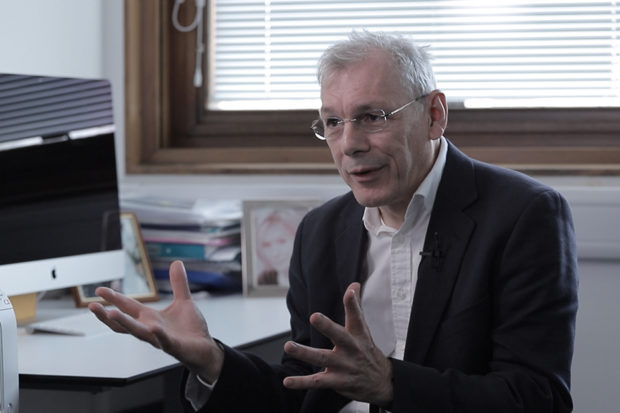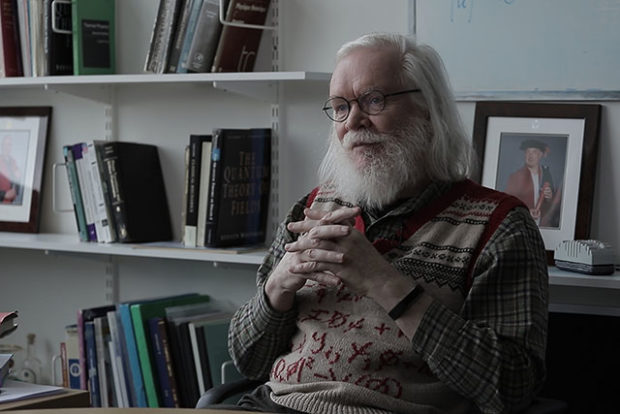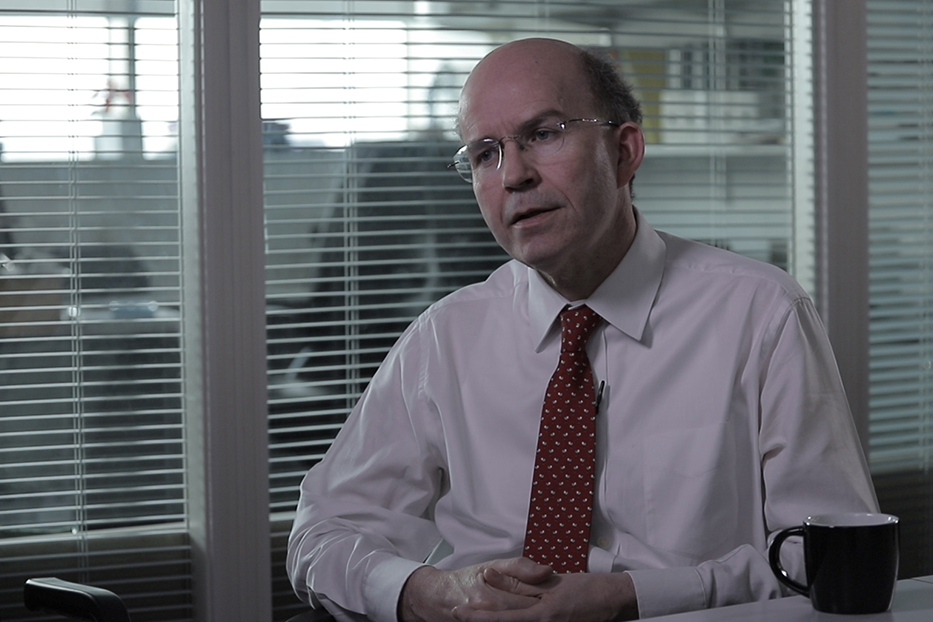Standard Cosmological Model
Astrostatistician Alan Heavens on the expanding Universe, cosmological constant, and why our cosmological model may be incomplete
videos | July 30, 2020
Let’s start with a few basic observations about the Universe. The first is that the Universe appears to be more or less the same wherever we look: not in detail, but if you look in one part of the sky, you’ll see the same sort of mix of galaxies, clusters of galaxies, voids, filaments and so on as you see everywhere else. In fact, our galaxy, the Milky Way, is very similar to galaxies throughout the Universe. So, there appears to be no special place in the Universe, and that underpins one of our ideas of the Universe.
The other idea which one might think about is that there’s no special time. In fact, in the past, we used to think that the Universe was static, unchanging, and existed forever. When Einstein formulated his theory of gravity in the general theory of relativity, he changed his theory to allow for a static Universe because otherwise, the Universe cannot be static; it will fall in on itself under gravity. So he introduced his cosmological constant, which is a repulsive force that exists even with no matter to try to balance out the gravitational pull of matter to make a static Universe. It wasn’t one of his better ideas, it has to be said, because such a Universe in delicate balance like that is actually unstable, so any small changes in the density will either cause it to collapse or to expand.

So, the Universe is expanding, and it was a big surprise. It was developed by Edwin Hubble, who found a particular law, which is that the expansion speed is proportional to the distance. So it seems there’s something strange about our position: everything is moving away from us, but this particular expansion law is not what it seems. It seems that we have a special place, but, in fact, what it represents is just an overall expansion of the Universe. If you imagine taking a camera and changing the zoom setting, then the picture stays the same, but everything just moves further apart, and that seems to be happening in the Universe. Any person in our galaxy would see everything else moving away from them according to Hubble’s law.
So although Hubble’s law seems to suggest that we’re at the centre, in fact, it’s exactly the opposite.
Let’s think about the consequences of the expanding Universe. If we were to run time backwards, then everything would be closer together, and any gas in the Universe would get hotter as it was contracted. Actually, if we run time backwards far enough, then there’s a point at which all the constituents of the Universe are sitting on top of each other; they have a zero separation. That event took place about 13.8 billion years ago, and it represents the beginning of the Universe as we understand it. The event is called the Big Bang: something (we don’t really understand fully what) sent the constituents of the Universe moving apart at high speed.
It sounds fanciful, but there’s plenty of evidence to support it, one of which comes from looking at the Universe when it was just a few minutes old. This is going back 13.8 thousand million years to within the first few minutes of the Universe’s history. At that stage, the Universe was very dense and very hot and, in some respects, resembled the centre of a hot star. We know that in those circumstances, the particles and the nuclei will be colliding with great energy, sufficient energy to form heavier nuclei, and the light elements get created in those first few minutes of the Big Bang. We can detect those; we can compare the abundances that happen from this so-called Big Bang nucleosynthesis event with what we see after adjusting for some changes that have happened since, and we find broad agreement.
Another thing is that we do detect the light that was left over from the hot Big Bang: it’s now been cooled to 2.7 degrees above absolute zero, so it’s now in the form of microwaves, but we detect that. We can also get an enormous amount of information from microwave background radiation, not just from its existence but from the fact that it’s not quite a uniform temperature; there are small variations that arise because the Earth is moving through the Universe. So it’s a bit hotter in the direction we’re moving, but if we discount that, then there are still some very small irregularities at the level of 10−5 that were probably made by some quantum fluctuations in the very early Universe. They are enormously valuable because they tell us what the constituents of the Universe are, how the Universe has expanded; they tell us about the gravity law and so on. All of these things affect the very detailed properties of these fluctuations in the microwave background, and what we see agrees very closely with what we expect from our standard cosmological model.
One of the things that we can tell is that there has to be a lot of dark matter in the Universe.
If we look at the level of fluctuations in the microwave background, they give us a snapshot of the Universe about 400,000 years after the Big Bang: before that, the Universe was ionised, and the photons of light scatter from the electrons, so it’s a fog before then. But at 400,000 years, the fog clears, and those photons have been doing more or less nothing except travel towards us to land in our telescopes. So we have this snapshot just after the Big Bang, and we can ask, is there time for those fluctuations to grow into the structures that we see today? The dense parts of the Universe collapse under gravity to form denser parts, so over time, the Universe becomes more clumpy. We can ask, is there time for that to happen?

Another ingredient of the standard model of the Universe is actually Einstein’s cosmological constant. It sort of wasn’t necessary for a while once the Universe was seen to be not static. But in recent years, in the late 1990s, by looking at the light from distant supernovae explosions, which act as standard candles, they’re all more or less the same brightness; we can measure how the Universe has been expanding. We find, much to our surprise, that the rate at which the Universe is expanding is increasing. The Universe is accelerating in its expansion, which is not what we expect at all because we expect gravity to slow down the expansion, but in fact, it’s getting faster. This was rewarded with the 2011 Nobel Prize, the discovery of the acceleration of the Universe.
So the question is, what is driving that acceleration? And the simplest explanation is that it’s Einstein’s cosmological constant. We can test this idea. There are other possibilities: it could be that the Universe has some field in it called dark energy, which behaves more or less like a cosmological constant. In a modern context, we would call it vacuum energy: if the vacuum has an energy associated with it, then it will cause an acceleration very similar to what we see. Having a vacuum with energy in it is not a big surprise from a particle physics point of view; what is a surprise is the very small level of the energy density which is needed: it’s about 120 orders of magnitude smaller than we might expect by applying particle physics theory. So it’s a big puzzle. Why it’s very small but not quite zero?
To summarize, the standard cosmological model starts with the Big Bang. It’s a more or less uniform Universe which is expanding and now accelerating. It’s more or less the same everywhere, it looks the same in all directions on a large scale, and it contains ordinary matter which is only about 5% of the energy budget of the Universe, much more dark matter whose nature we know something about but not in detail, and this mysterious stuff called dark energy which is possibly Einstein’s cosmological constant.
Basically, all of our large-scale observations support this idea.
There are a couple of areas where we think that there may be a slight problem. One is that the current expansion rate of the Universe appears to be slightly different from what we would expect from our knowledge of the Universe from other probes, particularly the microwave background radiation. It’s not at a level which is so significant that we are absolutely certain that they’re in disagreement, and I think we need to understand the astrophysics of the local measurements better. Another one is that the clumpiness of the Universe that we measure by various methods appears to be a little bit less than we would expect from the standard cosmological model. Again, this is not a very significant discrepancy, but if it’s confirmed, if both of these discrepancies are confirmed in the future with better data and we understand astrophysics well, then they might be pointing towards something having to change. Whether that’s dark energy being a more complicated form than vacuum energy or Einstein’s theory having to be modified on large scales, we don’t know.





























